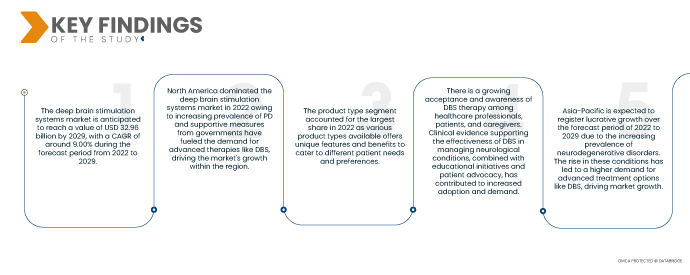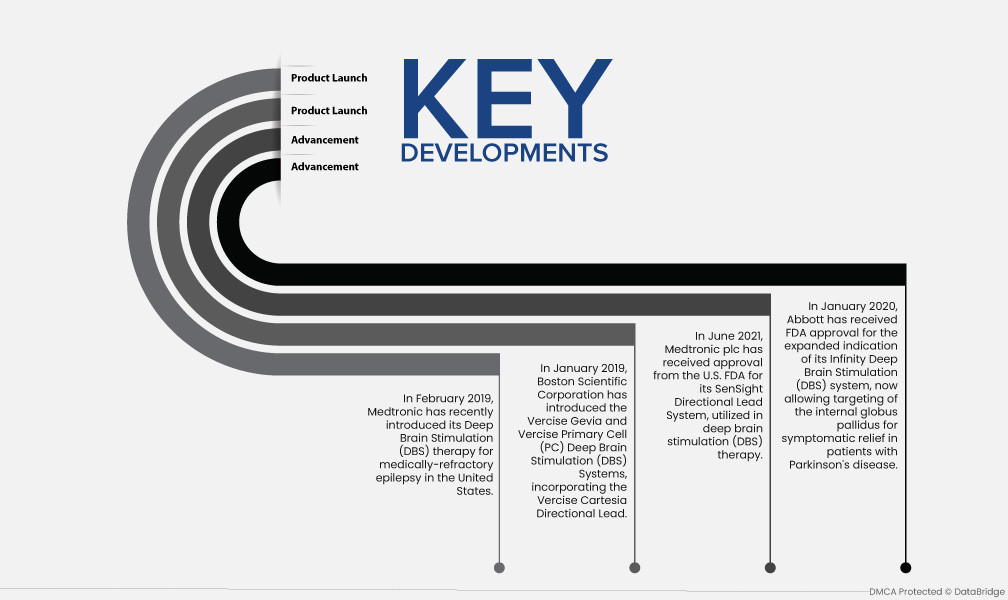Deep brain stimulation (DBS) systems are transforming the field of neurological treatment. This advanced technology involves the implantation of electrodes in specific areas of the brain to modulate abnormal electrical signals and alleviate symptoms of neurological disorders like Parkinson's disease, essential tremor, and dystonia. DBS systems offer significant advancements, providing personalized and adjustable therapy with improved symptom control and reduced medication dependence. Ongoing research explores the potential of DBS in treating various neurological conditions, paving the way for revolutionary advancements in neurological care and patient quality of life.
Access Full Report at https://www.databridgemarketresearch.com/jp/reports/global-deep-brain-stimulation-systems-market
Data Bridge Market Research analyses that the Global Deep Brain Stimulation Systems Market is valued at USD 1,208.97 million in 2021 and is expected to reach USD 32.96 billion by 2029, registering a CAGR of 9.00% during the forecast period of 2022 to 2029. Improved reimbursement policies and coverage for DBS procedures by healthcare systems and insurance providers have facilitated access to therapy. This has increased patient affordability and further fueled the market growth.
Key Findings of the Study
The growing incidence of neurological disorders is expected to drive the market's growth rate
The growing incidence of neurological disorders such as Parkinson's disease, essential tremor, dystonia, and obsessive-compulsive disorder (OCD) is fueling the demand for DBS systems. With an aging population and increasing awareness of these conditions, there is a rising need for effective treatment alternatives like DBS. This has created a favorable market environment, driving the adoption and growth of DBS systems as a promising therapeutic option for patients suffering from these neurological disorders.
Report Scope and Market Segmentation
|
Report Metric
|
Details
|
|
Forecast Period
|
2022 to 2029
|
|
Base Year
|
2021
|
|
Historic Years
|
2020 (Customizable to 2014-2019)
|
|
Quantitative Units
|
Revenue in USD Million, Volumes in Units, Pricing in USD
|
|
Segments Covered
|
Product Type (Single-Channel Deep Brain Stimulator, Dual-Channel Deep Brain Stimulator), Application (Obsessive Compulsive Disorder, Parkinson’s Disease, Essential Tremor, Epilepsy, Dystonia), Type (Rechargeable, Non-Rechargeable), End User (Hospitals, Ambulatory Surgical Centers (ASCs), Neurological Clinic)
|
|
Countries Covered
|
U.S., Canada and Mexico in North America, Germany, France, U.K., Netherlands, Switzerland, Belgium, Russia, Italy, Spain, Turkey, Rest of Europe in Europe, China, Japan, India, South Korea, Singapore, Malaysia, Australia, Thailand, Indonesia, Philippines, Rest of Asia-Pacific (APAC) in the Asia-Pacific (APAC), Saudi Arabia, U.A.E, South Africa, Egypt, Israel, Rest of Middle East and Africa (MEA) as a part of Middle East and Africa (MEA), Brazil, Argentina and Rest of South America as part of South America.
|
|
Market Players Covered
|
Boston Scientific Corporation (U.S.), Fisher Wallace (U.S.), SceneRay Corporation, Limited (China), Beijing PINS Medical Co., Ltd (China), ALEVA NEUROTHERAPEUTICS SA (Switzerland), MEDTRONIC (Ireland), and Abbott (U.S.)
|
|
Data Points Covered in the Report
|
In addition to the insights on market scenarios such as market value, growth rate, segmentation, geographical coverage, and major players, the market reports curated by the Data Bridge Market Research also include depth expert analysis, patient epidemiology, pipeline analysis, pricing analysis, and regulatory framework
|
Segment Analysis:
The deep brain stimulation systems market is segmented on the basis of product type, application, type, and end user.
- On the basis of product type, the deep brain stimulation systems market is segmented into single-channel deep brain stimulator and dual-channel deep brain stimulator. In 2022, single-channel deep brain stimulator segment is expected to dominate the market at CAGR 8.7% in the forecast period of 2022-2029 as single-channel deep brain stimulators typically have a simpler design and functionality compared to multi-channel systems.
In 2022, the single-channel deep brain stimulator segment is dominating the product type segment of the global deep brain stimulation systems market
In 2022, the single-channel deep brain stimulator segment is dominating the market in the forecast period of 2022-2029 as single-channel deep brain stimulators have been used for a longer time compared to more advanced multi-channel systems. This established use has generated a significant body of clinical data supporting their effectiveness and safety, contributing to their dominant market position.
- On the basis of application, the deep brain stimulation systems market is segmented into Parkinson’s Disease, essential tremor, dystonia, epilepsy, and obsessive-compulsive disorder. In 2022, the essential tremor segment is expected to dominate the market at CAGR 9.0% in the forecast period of 2022-2029 as essential tremor is one of the most common movement disorders, affecting a significant number of individuals globally.
In 2022, the essential tremor segment is dominating the application of the global deep brain stimulation systems market
In 2022, the essential tremor segment is dominating the application segment in the forecast period of 2022-2029 of the global deep brain stimulation systems market as essential tremor can significantly impact a person's quality of life, affecting daily activities and impairing motor control. For individuals with severe essential tremor symptoms that do not respond adequately to medication, DBS therapy can offer a viable treatment option.
- On the basis of type, global deep brain stimulation systems market is segmented into rechargeable and non-rechargeable. In 2022, rechargeable dominate the market at CAGR 8.6% in the forecast period of 2022-2029 as rechargeable deep brain stimulator systems typically offer longer battery life compared to non-rechargeable systems.
- On the basis of end user, the deep brain stimulation systems market is segmented into hospitals, ambulatory surgical centers (ASCs), and neurological clinic. The hospitals segment dominates at CAGR 8.7% in the forecast period of 2022-2029 as hospitals generally possess the necessary medical expertise and infrastructure to perform deep brain stimulation (DBS) procedures.
Major Players
Data Bridge Market Research recognizes the following companies as the major deep brain stimulation systems market players in deep brain stimulation systems market are Boston Scientific Corporation (U.S.), Fisher Wallace (U.S.), SceneRay Corporation, Limited (China), Beijing PINS Medical Co., Ltd (China), ALEVA NEUROTHERAPEUTICS SA (Switzerland), MEDTRONIC (Ireland), and Abbott (U.S.)
Market Development
- In February 2019, Medtronic has recently introduced its Deep Brain Stimulation (DBS) therapy for medically-refractory epilepsy in the United States. This innovative product launch is expected to expand Medtronic's customer base and drive revenue growth
- In January 2019, Boston Scientific Corporation has introduced the Vercise Gevia and Vercise Primary Cell (PC) Deep Brain Stimulation (DBS) Systems, incorporating the Vercise Cartesia Directional Lead.
- In June 2021, Medtronic plc has received approval from the U.S. FDA for its SenSight Directional Lead System, utilized in deep brain stimulation (DBS) therapy. This system integrates directionality with sensing capabilities, empowering physicians to administer precise and personalized DBS treatment tailored to individual patients.
- In January 2020, Abbott has received FDA approval for the expanded indication of its Infinity Deep Brain Stimulation (DBS) system, now allowing targeting of the internal globus pallidus for symptomatic relief in patients with Parkinson's disease.
Regional Analysis
Geographically, the countries covered in the deep brain stimulation systems market report are U.S., Canada and Mexico in North America, Germany, France, U.K., Netherlands, Switzerland, Belgium, Russia, Italy, Spain, Turkey, Rest of Europe in Europe, China, Japan, India, South Korea, Singapore, Malaysia, Australia, Thailand, Indonesia, Philippines, Rest of Asia-Pacific (APAC) in the Asia-Pacific (APAC), Saudi Arabia, U.A.E, South Africa, Egypt, Israel, Rest of Middle East and Africa (MEA) as a part of Middle East and Africa (MEA), Brazil, Argentina and Rest of South America as part of South America.
As per Data Bridge Market Research analysis:
North America is the dominant region in the deep brain stimulation systems market during the forecast period 2022 - 2029
In 2022, North America dominated the deep brain stimulation systems market due to the increase in the number of patients diagnosed with Parkinson's disease (PD) and the rising government funding and initiatives within the region. The rising prevalence of PD, a neurodegenerative disorder, has created a greater demand for effective treatment options like DBS. Moreover, the support from governments in the form of funding and initiatives has encouraged research, innovation, and accessibility to DBS systems, driving market growth and improving patient outcomes within the region.
Asia-Pacific is estimated to be the fastest growing region in the deep brain stimulation systems market for the forecast period 2022 - 2029
Asia-Pacific is expected to grow during the forecast period due to the increasing prevalence of neurodegenerative disorders in the region. The rising incidence of conditions such as Parkinson's disease, essential tremor, and dystonia has created a higher demand for effective therapeutic interventions like DBS. As the prevalence of neurodegenerative disorders continues to rise, there is a growing need for advanced treatment options, leading to the expansion of the DBS systems market within the region.
For more detailed information about the deep brain stimulation systems market report, click here – https://www.databridgemarketresearch.com/jp/reports/global-deep-brain-stimulation-systems-market














